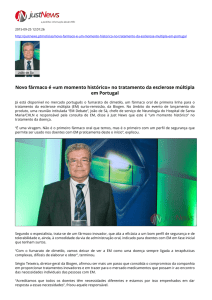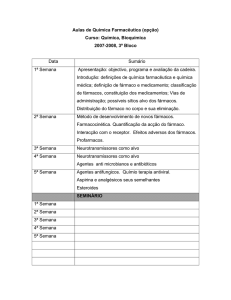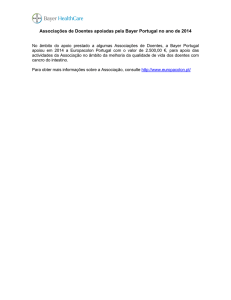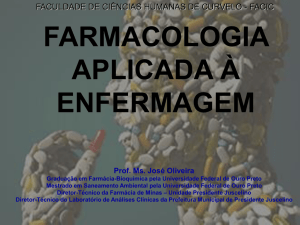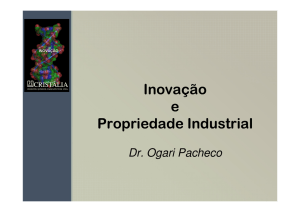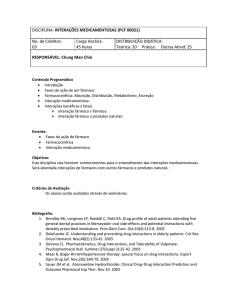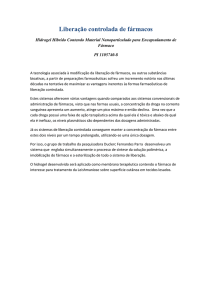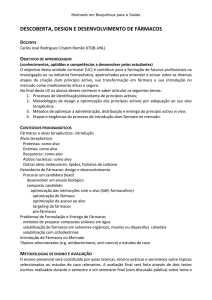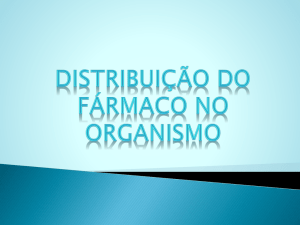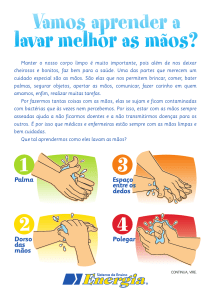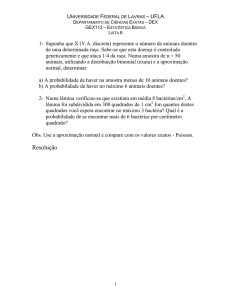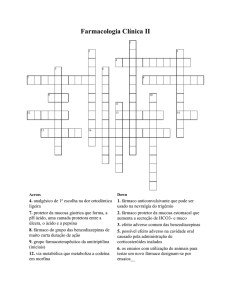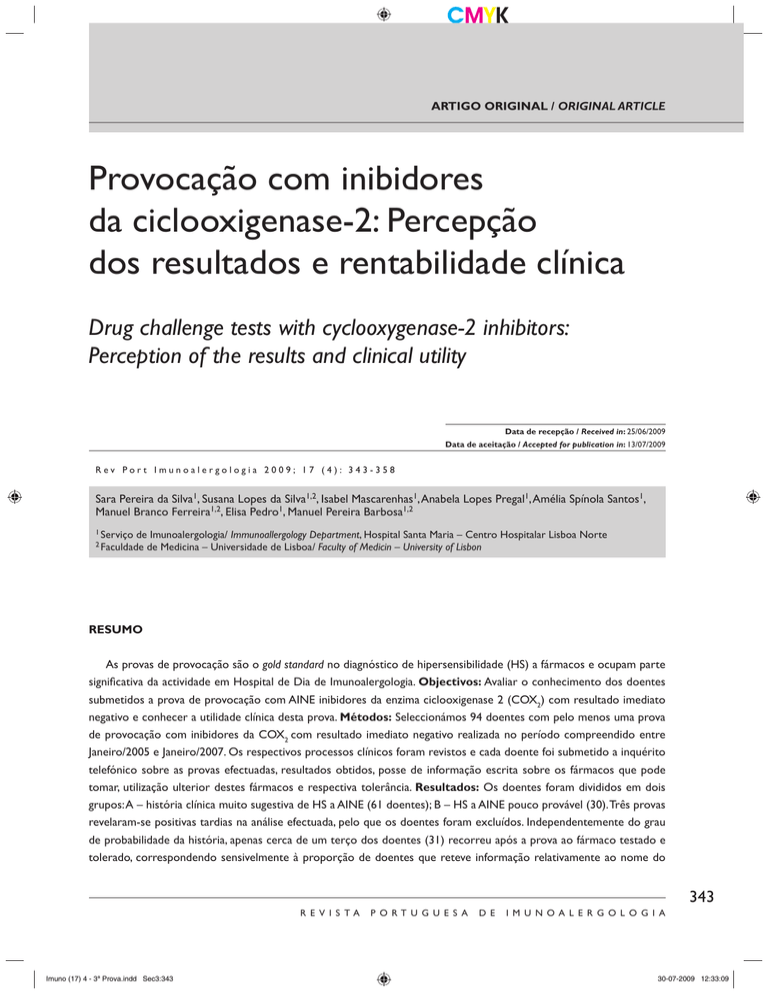
ARTIGO ORIGINAL / ORIGINAL ARTICLE
Provocação com inibidores
da ciclooxigenase-2: Percepção
dos resultados e rentabilidade clínica
Drug challenge tests with cyclooxygenase-2 inhibitors:
Perception of the results and clinical utility
Data de recepção / Received in: 25/06/2009
Data de aceitação / Accepted for publication in: 13/07/2009
Rev Port Imunoalergologia 2009; 17 (4): 343-358
Sara Pereira da Silva1, Susana Lopes da Silva1,2, Isabel Mascarenhas1, Anabela Lopes Pregal1, Amélia Spínola Santos1,
Manuel Branco Ferreira1,2, Elisa Pedro1, Manuel Pereira Barbosa1,2
1 Serviço
de Imunoalergologia/ Immunoallergology Department, Hospital Santa Maria – Centro Hospitalar Lisboa Norte
de Medicina – Universidade de Lisboa/ Faculty of Medicin – University of Lisbon
2 Faculdade
RESUMO
As provas de provocação são o gold standard no diagnóstico de hipersensibilidade (HS) a fármacos e ocupam parte
significativa da actividade em Hospital de Dia de Imunoalergologia. Objectivos: Avaliar o conhecimento dos doentes
submetidos a prova de provocação com AINE inibidores da enzima ciclooxigenase 2 (COX2) com resultado imediato
negativo e conhecer a utilidade clínica desta prova. Métodos: Seleccionámos 94 doentes com pelo menos uma prova
de provocação com inibidores da COX2 com resultado imediato negativo realizada no período compreendido entre
Janeiro/2005 e Janeiro/2007. Os respectivos processos clínicos foram revistos e cada doente foi submetido a inquérito
telefónico sobre as provas efectuadas, resultados obtidos, posse de informação escrita sobre os fármacos que pode
tomar, utilização ulterior destes fármacos e respectiva tolerância. Resultados: Os doentes foram divididos em dois
grupos: A – história clínica muito sugestiva de HS a AINE (61 doentes); B – HS a AINE pouco provável (30). Três provas
revelaram-se positivas tardias na análise efectuada, pelo que os doentes foram excluídos. Independentemente do grau
de probabilidade da história, apenas cerca de um terço dos doentes (31) recorreu após a prova ao fármaco testado e
tolerado, correspondendo sensivelmente à proporção de doentes que reteve informação relativamente ao nome do
343
R E V I S TA
Imuno (17) 4 - 3ª Prova.indd Sec3:343
P O RT U G U E S A
D E
I M U N OA L E R G O L O G I A
30-07-2009 12:33:09
Sara Pereira da Silva, Susana Lopes da Silva, Isabel Mascarenhas, Anabela Lopes Pregal, Amélia Spínola Santos,
Manuel Branco Ferreira, Elisa Pedro, Manuel Pereira Barbosa
fármaco e resultado da prova. 27/31 dos doentes utilizaram o fármaco dado como alternativa, com tolerância. Os quatro
doentes que não toleraram apresentaram reacção semelhante à que tinha motivado a prova, em média após 3,2 tomas
consecutivas do fármaco. Conclusões: A realização de provas de provocação exige elevado consumo de tempo e recursos humanos. Os resultados que obtivemos alertam para a necessidade de reforçar o esclarecimento dos doentes
com HS medicamentosa relativamente aos fármacos que podem ou não utilizar, no sentido de optimizar o benefício da
realização das provas de provocação.
Palavras-chave: Hipersensibilidade medicamentosa, hipersensibilidade a anti-inflamatórios não esteróides, provas de
provocação, tolerância.
ABSTRACT
Drug challenge tests are widely considered the gold-standard for establishing or excluding drug hypersensitivity (DH) and
represent an important proportion of our Outpatient Clinic activity. Objectives: Evaluate the level of awareness of safe alternative drugs for patients with previous negative drug challenge tests (DCT) to cyclooxygenase (COX)-2 inhibitors and assess
the clinical utility of the test. Methods: We selected 94 patients from our database with at least one negative drug test to
COX-2 inhibitors performed between January 2005 and January 2007. The respective clinical notes were reviewed and each
patient had a questionnaire-guided telephone interview. The patients were asked about the results of DCT performed,
whether they retained related written information regarding the drugs considered safe for them, if they had since taken them
and if they had been well tolerated. Results: Patients were divided into two groups: Group A–Clinical history highly suggestive
of hypersensitivity to non-steroidal anti-inflammatory drugs (NSAIDs) (61 patients); Group B–NSAID hypersensitivity less
likely (30 patients). Three DCT results were reclassified as late positive and those patients were excluded from the study.
Independent of the clinical history, approximately only one third of the patients (31) used the alternative drug, which corresponded somewhat to the proportion of patients that recalled the name of the recommended drug and result of the challenge
test. Twenty-seven of the 31 patients had used the recommended alternative drug, with tolerance. The four patients who did
not tolerate presented similar symptoms to those that motivated the DCT, appearing, on average, after 3.2 consecutive doses
of the drug. Conclusion: DCT procedures consume a huge amount of time and human resources. Our results show the need
to reiterate the information given to patients with drug hypersensitivity on the drugs they can use after the DCT, to optimise
the usefulness of these procedures.
Key-words: Drug hypersensitivity, nonsteroidal anti-inflammatory hypersensitivity, challenge test, tolerance.
344
R E V I S TA
P O RT U G U E S A
Imuno (17) 4 - 3ª Prova.indd Sec3:344
D E
I M U N OA L E R G O L O G I A
30-07-2009 12:33:27
PROVOCAÇÃO COM INIBIDORES DA CICLOOXIGENASE-2:
PERCEPÇÃO DOS RESULTADOS E RENTABILIDADE CLÍNICA / ARTIGO ORIGINAL
INTRODUÇÃO
INTRODUCTION
A
aspirina e outros anti-inflamatórios não esteróides (AINE) são fármacos amplamente utilizados
na prática clínica para o tratamento de diversas
patologias. Contudo, a ocorrência de reacções adversas
tem sido reportada com alguma frequência1-3. Em dois
estudos epidemiológicos efectuados em Portugal, 1,9% da
população adulta em geral2 e 4% da população adulta em
ambulatório hospitalar3 autorreportava alergia a ácido
acetilsalicílico e/ou outros AINE.
Os mecanismos fisiopatológicos subjacentes à hipersensibilidade ao ácido acetilsalicílico e a outros AINE não
se encontram completamente esclarecidos. Geralmente
estão envolvidos mecanismos não imunológicos, muitas
vezes relacionados com tipo e/ou doses dos fármacos utilizados. A inibição da enzima ciclooxigenase 1, desencadeada por estes fármacos, provoca uma redução da produção
de prostaglandina E2, com consequente aumento na produção de leucotrienos, constituindo um dos mecanismos
mais prováveis para as reacções desencadeadas4.
Os inibidores selectivos (coxibes) e parcialmente selectivos (nimesulide, meloxicam) da enzima ciclooxigenase 2
(inibidores COX2)5 são um subgrupo de fármacos habitualmente bem tolerados como alternativa nestes doentes, porque permitem que a enzima ciclooxigenase 1 mantenha a sua
actividade, pelo menos parcialmente, verificando-se que a sua
tolerância habitualmente está relacionada com a selectividade para a ciclooxigenase 2 (COX2) 5-13. A favor deste mecanismo fisiopatológico existem diversos trabalhos recentes a
demonstrar o aumento da tolerância a AINE inibidores da
COX2 em doentes com hipersensibilidade a AINE5-13.
Os testes cutâneos não são recomendados na investigação da maioria destes doentes e, embora existam avanços recentes importantes nos métodos in vitro para o
diagnóstico de hipersensibilidade a AINE14, estes não se
encontram ainda validados, pelo que o recurso a prova de
provocação se torna essencial na abordagem destes
doentes15-17.
W
hile aspirin and other non-steroidal anti-inflammatory drugs (NSAIDs) are widely
used in the clinical practice to treat a range
of clinical conditions, adverse reactions to them are commonly reported1-3.Two epidemiological studies conducted
in Portugal showed that 1.9% of the adult population as a
whole2 and 4% of the adult hospital outpatient population3 self-reported allergy to acetylsalicylic acid and/or
other NSAIDs.
The pathophysiological mechanisms underlying hypersensitivity to acetylsalicylic acid and other NSAIDs still
remain to be elucidated. They generally involve non-immunological mechanisms, very often related to the type
and/or dose of the drugs in question. Cyclooxygenase-1
inhibition, triggered by these drugs, leads to reduced prostaglandin E2 production, with consequent increased leukotriene production, being one of the more likely trigger
mechanisms of these reactions4.
Selective (coxibs) and partially selective (nimesulide, meloxicam) cyclooxygenase-2 inhibitors (COX-2)5 are a subgroup of NSAIDs, which are usually well tolerated as an alternative by these patients, as they allow cyclooxygenase-1 to
continue working at least partially, and their tolerance is usually associated to their selectivity to COX-25-13. Several recent
studies showing increased tolerance to NSAID COX-2 inhibitors in patients with hypersensitivity to NSAIDs have supported the idea of this pathophysiological mechanism5-13.
Skin tests are not recommended in investigating the
majority of these patients and, despite recent advances
in in vitro methods for diagnosing hypersensitivity to
NSAIDs14, these are not yet validated, meaning that drug
challenge tests (DCT) are essential in these patients15-17.
Once hypersensitivity to NSAIDs is diagnosed, it often
results in the patient being advised to avoid all drugs in the
group, with consequent prescription of second line drugs,
which are very often less efficacious and with a greater
toxicity18. In 2005, Schubert et al. found that 55% of the 260
345
R E V I S TA
Imuno (17) 4 - 3ª Prova.indd Sec3:345
P O RT U G U E S A
D E
I M U N OA L E R G O L O G I A
30-07-2009 12:33:27
Sara Pereira da Silva, Susana Lopes da Silva, Isabel Mascarenhas, Anabela Lopes Pregal, Amélia Spínola Santos,
Manuel Branco Ferreira, Elisa Pedro, Manuel Pereira Barbosa
O diagnóstico de hipersensibilidade a AINE frequentemente origina a recomendação de evicção de
todos os fármacos deste grupo, com consequente prescrição de fármacos de segunda linha, muitas vezes com
menor eficácia e maior toxicidade18. Em 2005, Schubert
et al verificaram que 55% dos 260 doentes referenciados com história de hipersensibilidade a AINE toleraram o fármaco que tinha implicado esse diagnóstico18.
Os autores consideram que, sempre que possível, o
diagnóstico deve ser confirmado pela realização de
prova de provocação (PP) com o fármaco implicado,
embora no estudo em questão essa prova não tenha
sido efectuada em 31%, nomeadamente por ter sido
rejeitada por esses doentes. No entanto, noutros trabalhos, 5 a 16% dos doentes com reexposição ao AINE
sugerido como alternativa, na sequência de prova de
provocação negativa, tiveram nova reacção de hipersensibilidade19-22.
Apesar do que foi discutido, o diagnóstico de hipersensibilidade a AINE na prática clínica é frequentemente baseado apenas na história clínica. Quaisquer sintomas relacionados temporalmente com a toma do AINE
podem ser interpretados como hipersensibilidade pelo
próprio doente e pelo médico. No entanto, podem existir outras causas para esses sintomas, como a patologia
subjacente que motivou essa terapêutica ou a toma
concomitante de outros fármacos. Exactamente devido
a este facto, no presente estudo tentámos também avaliar até que ponto o grau de probabilidade da história
influenciaria de forma relevante a informação que os
doentes retêm após os procedimentos de diagnóstico
efectuados.
patients referred with a history of hypersensitivity to NSAIDs
tolerated the drug implicated in the clinical diagnosis18.The
authors feel that, whenever possible, the clinical diagnosis
should be confirmed by performing a challenge test to the
drug in question, although this was not performed in their
study in 31% of patients, as they refused to undergo it. In
other studies, 5-16% of patients re-exposed to an alternative NSAID, recommended in view of a negative challenge
test, had a new hypersensitivity reaction19-22.
Despite the above, diagnosing hypersensitivity to NSAIDs
in the clinical practice is usually based on the clinical history
alone. Any symptom that starts soon after taking a NSAID
may be interpreted as hypersensitivity by the patient and
his/her physician, although the symptoms could have other
causes, such as an underlying condition which led to that
NSAID being prescribed or the concomitant intake of
other drugs. These are exactly the reasons why we also
attempted to evaluate the likelihood of a patient’s history
impacting in a significant way on the information he or she
retains after the diagnostic process.
AIMS
To evaluate the level of patient awareness of their DCT,
and assess the clinical utility of the test, namely by seeing
if patients had been using the safe alternative drugs tolerated in the DCT and if these had been well tolerated. If
these drugs had not been taken since the DCT, the
reason(s) were recorded.
METHODS
OBJECTIVOS
Avaliar o grau de esclarecimento dos doentes relativamente à prova a que foram submetidos; avaliar a rentabilidade clínica da prova, nomeadamente se tinham utiliza-
From our database which holds records of all outpatient
DCT, we identified 106 patients with at least one negative
DCT to COX-2 inhibitors, between January 2005 and January
2007. The DCT were performed using ENDA/EAACI methodology17, consisting of an initial placebo dose followed by
346
R E V I S TA
P O RT U G U E S A
Imuno (17) 4 - 3ª Prova.indd Sec3:346
D E
I M U N OA L E R G O L O G I A
30-07-2009 12:33:27
PROVOCAÇÃO COM INIBIDORES DA CICLOOXIGENASE-2:
PERCEPÇÃO DOS RESULTADOS E RENTABILIDADE CLÍNICA / ARTIGO ORIGINAL
do os fármacos tolerados na PP e qual tinha sido a sua
tolerância. No caso de não ter havido utilização deste
fármaco após a prova, averiguar o(s) motivo(s).
MÉTODOS
A partir de uma base de dados comum, onde são
registadas todas as provas de provocação realizadas no
Hospital de Dia, identificámos 106 doentes com pelo
menos uma PP oral com inibidores da COX2 com resultado imediato negativo, realizada entre Janeiro de
2005 e Janeiro de 2007. As PP orais foram efectuadas
de acordo com a metodologia proposta pela ENDA/
/EAACI17, consistindo na administração de uma dose
inicial de placebo, seguida da administração de doses
crescentes do fármaco até ser atingida a dose cumulativa terapêutica, permanecendo os doentes em observação por um período mínimo de quatro horas após a
última toma. Após a PP, os doentes eram cuidadosamente informados sobre os procedimentos e fármacos
que deviam evitar e que podiam utilizar, sendo-lhes fornecida informação escrita relativamente ao resultado
da prova (Figura 1).
Não foi possível entrar em contacto com 12 destes
doentes, tendo sido estudados 94. Três provas revelaram-se positivas tardias na análise do processo e/ou no inquérito telefónico efectuado, pelo que esses doentes foram
excluídos.
Foi efectuada consulta do processo clínico de cada
doente, com registo do sexo, idade à data da prova, fármaco da reacção (ácido acetilsalicílico / outro AINE), tipo
de reacção apresentada e o fármaco com que efectuou PP
oral. Os doentes foram divididos em dois grupos. Grupo
A: 61 doentes com história clínica muito sugestiva de HS
a AINE (reacção que ocorreu com AINE único e/ou vários
episódios de reacções com AINE), e grupo B, com 30 doentes em que a HS a AINE não era tão provável (reacções
ocorrendo durante a toma de vários fármacos em simul-
increasing doses of the drug until the cumulative therapeutic
dose was reached. Patients remained in observation for at
least four hours after the last dose. Following the DCT, patients received detailed information regarding the procedures
and the drugs to be avoided and taken. Patients were given
written information on the challenge test results (Figure 1).
As it was not possible to make contact with 12 of these
patients, we studied 94. Three DCT results were reclassified as late positive following review of the clinical file and/
or telephone interview and were excluded from analysis.
We reviewed each patient’s clinical records for gender,
age at date of test, drug which caused the reaction (acetyl-
Figura 1. Folha com informação escrita relativamente aos resultados da prova efectuada, à data deste estudo
Figure 1. Written information sheet of the DCT as of the date of this
study
347
R E V I S TA
Imuno (17) 4 - 3ª Prova.indd Sec3:347
P O RT U G U E S A
D E
I M U N OA L E R G O L O G I A
30-07-2009 12:33:27
Sara Pereira da Silva, Susana Lopes da Silva, Isabel Mascarenhas, Anabela Lopes Pregal, Amélia Spínola Santos,
Manuel Branco Ferreira, Elisa Pedro, Manuel Pereira Barbosa
2005
2007
106 doentes PPO negativa com inibidores da COX2
106 patients DCT negative to COX2 inhibitors
12 doentes não
contactáveis /
12 patients could
not be contacted
94 doentes contactados
94 patients contacted
3 doentes PPO
positiva tardia /
3 patients positive
DCT late onset
91 doentes / 91 patients
61 doentes / 61 patients
30 doentes / 30 patients
HS a AINE muito provável /
HS to NSAID very likely
HS a AINE menos provável /
30 patients HS to NSAID less likely
Legenda: PPO – prova de provocação oral; COX – ciclooxigenase; HS – hipersensibildade; AINE – anti-inflamatórios não esteróides
Legend: DCT – drugs challenge test; COX – cyclooxigenase; HS – hipersensivity; NSAID – non-steroid anti-imflammatory drug
Figura 2. Desenho do estudo
Figure 2. Study design
tâneo: antibióticos, anestésicos, analgésicos e/ou diferentes
tipos de AINE) (Figura 2).
Cada doente foi submetido a inquérito telefónico questionando qual o fármaco testado, o resultado obtido e a
posse de algum documento com indicações sobre os fármacos que poderia ou não tomar. Também era questionado
sobre a utilização do fármaco dado como alternativa, a dosagem e período de tempo máximo de uso contínuo, bem
como sobre a ocorrência ou não de qualquer reacção. Nos
doentes que referiram reacção foi pesquisada a utilização
de outros fármacos concomitantes, febre ou infecção.
Os doentes que não tinham tomado o fármaco foram
questionados sobre a existência de eventual receio em
relação à utilização desse fármaco, bem como sobre a
utilização de outros fármacos, nomeadamente paraceta-
salicylic acid/other NSAID), type of reaction presented and
the drug used in the DCT. The patients were divided into
2 groups. Group A was composed of 61 patients with a
clinical history highly suggestive of NSAID hypersensitivity
(reactions in which the only drug taken was a NSAID and/
or several episodes of reactions following NSAID intake).
Group B was composed of 30 patients with less probable
NSAID hypersensitivity (reactions appearing while taking
several drugs simultaneously: antibiotics, anaesthetics,
analgesics and/or different types of NSAID) (Figure 2).
Each patient underwent a telephone interview regarding
the name of the drug tested, the result obtained and if they had
any written document showing which drugs to avoid and which they could take.They were also asked about the efficacy of
the drug recommended as an alternative, the dose, the maxi-
348
R E V I S TA
P O RT U G U E S A
Imuno (17) 4 - 3ª Prova.indd Sec3:348
D E
I M U N OA L E R G O L O G I A
30-07-2009 12:33:28
PROVOCAÇÃO COM INIBIDORES DA CICLOOXIGENASE-2:
PERCEPÇÃO DOS RESULTADOS E RENTABILIDADE CLÍNICA / ARTIGO ORIGINAL
mol, anti-inflamatórios enzimáticos ou analgésicos derivados dos opiáceos.
Para a análise estatística foi utilizado o software Graphpad Prism 5, aplicando o teste exacto de Fisher na comparação entre os dois grupos.
RESULTADOS
O grupo A incluiu 61 doentes, 67% do sexo feminino,
idade média 47±15 anos. Em 44% dos doentes, o fármaco
implicado na reacção era o ácido acetilsalícilico e em 56%
outros AINE não selectivos. Em 82% dos doentes a reacção
que motivou a prova foi urticária e/ou angioedema, 3%
tiveram apenas sintomas respiratórios e 15% anafilaxia.
Neste grupo, todas as provas que analisámos tiveram como
objectivo encontrar uma alternativa, sendo que em 46%
das provas o fármaco utilizado foi o nimesulide e, nas
restantes, o etoricoxibe.
O grupo B incluiu 30 doentes, 93% do sexo feminino,
idade média 47±14 anos. Em 15% o ácido acetilsalicílico
era o AINE suspeito. 80% dos doentes apresentaram, no
momento da reacção que motivou a prova, urticária e/ou
angioedema, 3% sintomas respiratórios e 17% anafilaxia.
Neste grupo, com história de toma, no momento da reacção, de AINE e um ou mais fármacos de outros grupos, os
objectivos das provas variaram:
a) 50% tiveram como objectivo encontrar uma alternativa segura, em doentes em que a gravidade da
reacção apresentada contraindicava a realização de
prova de diagnóstico ou que recusaram efectuar
prova com o fármaco implicado;
b) 17% foram provas de segurança, efectuadas com o
objectivo de determinar se o fármaco da prova era
bem tolerado, quando não foi possível identificar
exactamente o AINE implicado na reacção e havendo necessidade de o doente ter um AINE disponível
como alternativa terapêutica;
mum continuous use period and if they had any reaction to
this or not. Patients who complained of a reaction were asked
about the use of any concomitant drugs, fever or infection.
Patients who had never taken the drug were asked if
they had any fear about using it.They were also asked about
using any other drugs, namely paracetamol, enzymatic anti-inflammatory drugs or opiate-based analgesics.
We used the software Graphpad Prism 5 for statistical
analysis and Fisher exact test for comparisons between
the two groups.
RESULTS
Group A included 61 patients, 67% female, mean age
47±15 years old. Acetylsalicylic acid was the drug causing
the reaction in 44% of patients and other non-selective
NSAIDs in 56%. Urticaria and/or angiooedema was the
reaction that led to the DCT in 82% of patients, with 3%
presenting only respiratory symptoms and 15% anaphylaxis. In this group, all the tests we analysed were aiming to
find an alternative. The drug used in 46% of the DCT was
nimesulide and etoricoxib in the remainder.
Group B had 30 patients, 93% female, mean age 47±14
years old. Acetylsalicylic acid was the suspected NSAID
in 15%. At the moment of the reaction which led to the
DCT, 80% of patients presented urticaria and/or angioedema, 3% only respiratory symptoms and 17% anaphylaxis.
There were several aims to the DCT in this group, with a
history of taking NSAID and one or more drugs of other
groups at the moment of reaction:
a) Fifty per cent were aiming to find a safe alternative,
in patients in whom the severity of the reaction
contraindicated DCT or in patients who refused to
undergo a DCT with the suspected drug;
b) Seventeen per cent were safety tests, performed to
see if the drug tested was well tolerated, when it
was not possible to identify exactly which NSAID
349
R E V I S TA
Imuno (17) 4 - 3ª Prova.indd Sec3:349
P O RT U G U E S A
D E
I M U N OA L E R G O L O G I A
30-07-2009 12:33:28
Sara Pereira da Silva, Susana Lopes da Silva, Isabel Mascarenhas, Anabela Lopes Pregal, Amélia Spínola Santos,
Manuel Branco Ferreira, Elisa Pedro, Manuel Pereira Barbosa
c) 33% das provas foram de diagnóstico, ou seja, nestes
doentes a suspeita de hipersensibilidade ao AINE
inibidor da COX2 não se confirmou.
O nimesulide foi o fármaco testado em 73% do total
das provas efectuadas no grupo B, sendo o etoricoxibe
testado nas restantes.
A distribuição relativamente à idade, sexo e sintomas
da reacção inicial foi homogénea entre os dois grupos.
Independentemente do grau de probabilidade da história, e com proporções semelhantes nos dois grupos, apenas
cerca de um terço dos doentes recorda o nome do fármaco
testado (Quadro 1), embora cerca de 80% se recorde de
que a prova foi negativa (comparação entre os dois grupos,
p>0,05). Apenas cerca de metade dos doentes, em ambos
os grupos, é portadora de informação escrita relativamente à investigação efectuada (comparação entre os dois grupos, p>0,05). Trinta e um doentes (34%) tomaram o fármaco após a prova de provocação, sendo que todos recordam
o nome do fármaco utilizado na PP, independentemente do
grupo. 16/19 dos doentes do grupo A e 11/12 dos doentes
do grupo B toleraram a toma do fármaco alternativo
(p>0,05). O fármaco não tolerado foi o etoricoxibe num
doente do grupo A e o nimesulide em dois do grupo A e
no doente do grupo B. Os quatro que não toleraram tiveram reacção semelhante à que tinha motivado a prova, em
média após 3,2 tomas do fármaco, no contexto de processos inflamatórios (nomeadamente dores ostearticulares,
tendinite e/ou odinofagia), sem febre e sem qualquer outra
medicação concomitante. É igualmente de referir que nenhum destes doentes apresentava urticária crónica.
As razões para não ter tomado o fármaco foram ligeiramente diferentes nos dois grupos (p>0,05), referindo a
maioria do grupo A que “não necessitou”, enquanto no
grupo B o receio foi o motivo mais citado, contrastando
com a boa tolerância global dos doentes que recorreram
ao fármaco (Quadro 1).
Dos doentes que não tomaram o fármaco dado como
alternativa, nenhum tomou outros fármacos, nomeada-
led to a reaction and the patient needed a NSAID
available as alternative treatment;
c) Thirty-three per cent were diagnostic, that is, these
patients had supected hypersensitivity to a COX-2
inhibitor, which was not confirmed by the DCT.
Nimesulide was the drug tested in 73% of the total
tests performed in Group B, with etoricoxib tested in the
remainder.
The two groups had a homogeneous distribution of
age, gender and initial reaction symptoms. Independent
of likelihood of the clinical history, only one third of
patients recalled the name of the drug tested, with similar proportion in both groups (Table 1). Although around
80% recalled that the test was negative (comparison between the groups p > 0.05), only approximately half of
the patients in both groups retained the written information on the investigation performed (comparison beween
the groups p > 0.05).Thirty-one patients (34%) took the
drug after the CT, with all of these recalling the name of
the drug used in the test, independent of the group. In
group A, 16/19 and in Group B 11/12 patients tolerated
the alternative drug (p > 0.05). One patient in Group A
did not tolerate etoricoxib. Nimesulide was not tolerated
by two Group A patients and one Group B patient. The
four patients who could not tolerate these drugs had a
similar reaction which led to the DCT, on average after
3.2 doses of the drug. The reasons for taking COX-2
inhibitors were always inflammatory conditions (ostearticular pain, tendinitis and/or odynophagia), with no
fever and no other concomitant medication. No patient
had chronic urticaria.
The reasons for not having taken the drug differed
slightly from group to group (p > 0.05). The majority of
Group A patients said they ‘did not need it’ while ‘fear’ was
the reason given most often in Group B, contrasting with
the good overall tolerance of patients who took the drug
(Table 1). None of the patients who did not take the drug
given as an alternative, took other drugs, namely parace-
350
R E V I S TA
P O RT U G U E S A
Imuno (17) 4 - 3ª Prova.indd Sec3:350
D E
I M U N OA L E R G O L O G I A
30-07-2009 12:33:28
PROVOCAÇÃO COM INIBIDORES DA CICLOOXIGENASE-2:
PERCEPÇÃO DOS RESULTADOS E RENTABILIDADE CLÍNICA / ARTIGO ORIGINAL
Quadro 1. Resumo de resultados dos inquéritos efectuados em ambos os grupos
Table I. Summary of the results of the interviews in both groups
Recordam-se
do fármaco
da PP /
Recalled the CT
drug
Recordam-se
do resultado
da PP /
Recalled the CT
result
Portador de
informação
escrita /
Retained
the written
information
A (n=61)
37%
(n=22)
79%
(n=48)
B (n=30)
40%
(n=12)
Total
(n=91)
37%
(n=34)
Utilização ulterior do fármaco / Used the drug
Sim / Yes
Não / No
Total
(n=31)
T
Total
(n=60)
NN
R
51%
(n=31)
31%
(n=19)
84%
(n=16)
69%
(n=42)
69%
(n=29)
31%
(n=13)
80%
(n=24)
47%
(n=14)
40%
(n=12)
92%
(n=11)
60%
(n=18)
44%
(n=8)
50%
(n=9)
79%
(n=72)
49%
(n=45)
34%
(n=31)
87%
(n=27)
66%
(n=60)
62%
(n=37)
37%
(n=22)
Legenda / Legend: PP / CT – Prova de provocação / challenge test; T – Tolerou / Tolerated; NN – Não necessitou / No need;
R – Receio / Fear
mente paracetamol, anti-inflamatórios enzimáticos ou
analgésicos derivados dos opiáceos.
O intervalo entre a realização da prova e o inquérito
variou entre 6 e 30 meses.
tamol, enzymatic anti-inflammatory drugs or opiate-based
analgesics.
The interval between undergoing the test and the interview varied from 6 to 30 months.
DISCUSSÃO
DISCUSSION
As PP com fármacos são consideradas gold standard no
diagnóstico de hipersensibilidade medicamentosa, podendo ser efectuadas com o objectivo de confirmar ou excluir
hipersensibilidade medicamentosa ou para encontrar fármacos alternativos seguros e bem tolerados em doentes
com este diagnóstico15-17.
No nosso Hospital de Dia de Imunoalergologia, à data do
estudo eram efectuadas em média duas PP diariamente, representando uma proporção importante da actividade desenvolvida. As indicações para PP com fármacos são estabelecidas conforme as indicações da EAACI (ENDA)17. De
acordo com os dados de um estudo prévio24, de Outubro
de 2000 a Junho de 2006, foram efectuadas 667 PP com AINE
no nosso Hospital de Dia, constituindo a classe de fármacos
mais testada. Setenta e nove por cento das PP orais com AINE
Challenge tests to drugs are considered the gold
standard in diagnosing drug hypersensitivity (DH) and
they can be performed to confirm or rule out DH or
to find safe, well-tolerated alternative drugs for patients
diagnosed with DH15-17. Two DCT per day were performed at our hospital’s Immunoallergology outpatient
clinic at the time this study was undertaken. This represents a significant amount of time given over to this
activity. DCT to drugs are performed in line with the
EAACI (ENDA) guidelines17. According to data from a
previous study 24, from October 2000 to June 2006,
667 DCT to NSAIDs were performed at our outpatient
clinic. More tests were performed to NSAIDs than any
other drugs. Seventy-nine per cent of the oral DCT to
NSAIDs were performed to find an alternative that the
351
R E V I S TA
Imuno (17) 4 - 3ª Prova.indd Sec3:351
P O RT U G U E S A
D E
I M U N OA L E R G O L O G I A
30-07-2009 12:33:28
Sara Pereira da Silva, Susana Lopes da Silva, Isabel Mascarenhas, Anabela Lopes Pregal, Amélia Spínola Santos,
Manuel Branco Ferreira, Elisa Pedro, Manuel Pereira Barbosa
foram efectuadas com o objectivo de encontrar uma alternativa tolerada pelo doente. No entanto, os dados da literatura relativamente à avaliação do resultado prático / impacto
ou repercussão do procedimento de provas de provocação
na avaliação da hipersensibilidade a fármacos são escassos.
No presente estudo, a frequência de reacções após reexposição ao fármaco foi de 13%. Em 1997, Quaratino et al
avaliaram a tolerância a longo prazo do nimesulide e paracetamol em 248 doentes com HS a AINE 19. Estes doentes, que
tinham tolerado nimesulide e/ou paracetamol em prova de
provocação oral com uma dose correspondente a uma toma
única do fármaco, foram submetidos a uma entrevista, 1 a 3
anos após a prova, para averiguar a sua tolerância. Dos 159
doentes (64%) que tomaram um ou ambos os fármacos testados, 5% tiveram reacções adversas. Os autores não avaliaram os motivos para não ter utilizado o fármaco dado como
alternativa e também não fazem referência a qual foi o período de utilização consecutiva do fármaco, utilização simultânea
de outros fármacos, nem especificam se os doentes que tiveram reacções apresentavam febre ou sintomas de infecção.
Relativamente à frequência de reacções após exposição a
nimesulide e/ou paracetamol (5%), é importante salientar que
o paracetamol é um fármaco com menor potencial de inibição da enzima ciclooxigenase 2 e, portanto, é frequentemente bem tolerado pela grande maioria de doentes com hipersensibilidade a AINE. Adicionalmente, os autores não fazem
referência ao número de tomas consecutivas, que pode influenciar significativamente a tolerância a estes fármacos.
Em 2005, outro grupo testou a tolerância a longo prazo
do rofecoxibe20. Foram estudados 182 doentes com PP negativas com rofecoxibe, os quais foram reavaliados entre 1 e
3 anos após a realização da prova. O fármaco não fora utilizado por 51 doentes (28%): vinte e nove (57%) referiam não ter
sido necessário e 22 (43%) ter tido receio de possíveis reacções adversas. Dos 131 doentes que voltaram a tomar rofecoxibe, 5% reportaram reacções adversas. Nenhum dos doentes estava a efectuar outra medicação concomitante e todos
tinham efectuado múltiplas tomas do fármaco (média 3,8).
Contudo, neste estudo, os autores não discutem o facto de
patient could tolerate. There is not a great deal in the
literature on evaluating the practical result/impact or
repercussion of the CT procedure in assessing HS to
drugs.
We found a 13% frequency of reactions following
re-exposure to the drug. In 1997, Quaratino et al. evaluated long-term tolerance to nimesulide and paracetamol in 248 patients with HS to NSAIDs 19. These
patients, who had tolerated nimesulide and/or paracetamol in oral DCT with a dose equivalent to one
single administration of the drug, were interviewed 1-3
years after the test to assess their tolerance. Five per
cent of the 159 patients who took one or both drugs
had adverse reactions. The authors did not probe the
reasons why patients did not use the drug recommended
as an alternative; neither do they state the drug’s consecutive period of use, any simultaneous use of other
drugs, or specify if the patients with reactions presented fever or symptoms of infection. In terms of the
frequency of reactions following exposure to nimesulide and/or paracetamol (5%), it should be stressed that
paracetamol has a lesser inhibition potential of the
cyclooxygenase-2 enzyme and, thus, is generally well
tolerated by the great majority of NSAID hypersensitive patients. In addition, the authors made no reference
to the number of consecutive drug administrations,
which could have impacted significantly on tolerance
to these drugs.
In 2005, another group tested long-term tolerance
to rofecoxib20, where 182 patients with negative DCT
to rofecoxib were studied, and evaluated 1-3 years after the test. Fifty-one patients (28%) had not taken the
drug, 29 (57%) had had no need and 22 (43%) had been
afraid of a possible adverse reaction. Five per cent of
the 131 patients who had retaken rofecoxib reported
adverse reactions. None of these patients was taking a
concomitant drug and all had taken multiple doses
(mean 3.8). The authors, however, do not discuss the
fact that 22 patients had not taken the drug out of fear
352
R E V I S TA
P O RT U G U E S A
Imuno (17) 4 - 3ª Prova.indd Sec3:352
D E
I M U N OA L E R G O L O G I A
30-07-2009 12:33:28
PROVOCAÇÃO COM INIBIDORES DA CICLOOXIGENASE-2:
PERCEPÇÃO DOS RESULTADOS E RENTABILIDADE CLÍNICA / ARTIGO ORIGINAL
22 doentes não terem tomado o fármaco por receio de reacção, apesar do procedimento a que tinham sido submetidos.
Referem ainda que a tolerância a longo prazo pode estar sub
ou sobreestimada porque uma proporção considerável de
doentes não utilizou o fármaco. Neste estudo, o número de
doentes que tomou o fármaco foi consideravelmente superior
(131) ao do presente estudo (31). O rofecoxibe não está
actualmente disponível no nosso país, mas, dentro deste grupo de fármacos, é reconhecidamente um dos que apresenta
maior selectividade para a enzima COX24.
Em 2007, um estudo efectuado em Portugal avaliou as
reacções positivas em doentes reexpostos ao fármaco suspeito após provocações diagnósticas negativas com diversos
tipos de fármacos, incluindo AINE, efectuadas nos sete anos
precedentes. Os autores verificaram que 16% dos doentes
que foram reexpostos ao fármaco anteriormente tolerado
apresentaram reacção21. Contudo, neste estudo, a ocorrência de reacção na reexposição incluiu diferentes tipos de
fármacos, entre os quais AINE (5 de 19 doentes), e o principal motivo para reexposição ao fármaco foi o tratamento
de infecções do tracto respiratório superior, o que pode
explicar a maior percentagem de reacções observadas.
Em 2005, Çelik et al efectuaram um estudo de avaliação
da tolerância a longo prazo de inibidores da COX2 em 87
doentes com intolerância a analgésicos22. Num intervalo de
7 anos, 61 doentes (70%) utilizaram o fármaco, 11% dos quais
(7 doentes) reportaram efeitos adversos. Destes sete doentes, três foram submetidos novamente a prova de provocação,
que se revelou negativa. A frequência de reacções na reexposição ao fármaco foi semelhante à que encontrámos no
presente trabalho. O desenho deste estudo é idêntico ao
nosso, embora não tenhamos repetido a prova de provocação nos doentes que referiram reacção com o fármaco alternativo. Além disso, este estudo avaliou a utilização do
fármaco alternativo em alguns casos até sete anos após a
realização da prova, enquanto alguns dos nossos doentes
tinham efectuado a prova apenas cerca de 6 meses antes.
Este facto terá seguramente contribuído para o reduzido
número de doentes que utilizaram o fármaco, uma vez que,
of reactions, despite the procedure they had undergone. Further, long-term tolerance may be under- or
overestimated, as a considerable proportion of patients
did not use the drug. The number of patients who took
the drug was markedly higher (131 patients) in this
study than in ours (31 patients). Rofecoxib is not currently available in Portugal but it is recognised as being
one of this class of drugs with greater selectivity for
COX-24.
A 2007 study undertaken in Portugal, assessed
positive reactions in patients re-exposed to the suspect drugs following negative diagnostic DCT, performed within the seven preceding years, to several
types of drugs, including NSAIDs. The authors found
that 16% of patients re-exposed to the drug they formerly tolerated presented a reaction21. In this study,
however, reaction upon re-exposure included different
types of drugs, among which were NSAIDs (5 out of
19 patients), and the main reason for re-exposure to
the drug was to treat upper respiratory tract infections, which could explain the higher percentage of
reactions seen.
Çelik et al. evaluated long-term tolerance to COX-2
inhibitors in 87 patients with intolerance to analgesics22. Sixty-one patients (70%) used the drug over a
7-year interval and 11% of those (7 patients) reported
adverse effects. Three of these seven underwent a further DCT, which proved negative. The frequency of
reactions upon re-exposure was similar to that we saw.
The design of that study is identical to ours, although
we did not repeat the DCT in the patients who reported a reaction to the alternative drug. Moreover,
that study evaluated the use of an alternative drug in
some cases seven years after undergoing the DCT,
while some of our patients had undergone DCT only
6 months previously. This could certainly have contributed to the reduced number of patients who used the
drug; in our study the time lag following the DCT varied from 6 to 30 months only.
353
R E V I S TA
Imuno (17) 4 - 3ª Prova.indd Sec3:353
P O RT U G U E S A
D E
I M U N OA L E R G O L O G I A
30-07-2009 12:33:28
Sara Pereira da Silva, Susana Lopes da Silva, Isabel Mascarenhas, Anabela Lopes Pregal, Amélia Spínola Santos,
Manuel Branco Ferreira, Elisa Pedro, Manuel Pereira Barbosa
no nosso estudo, o intervalo de tempo após a realização da
prova variou apenas entre 6 e 30 meses.
No presente estudo, os doentes foram divididos em dois
grupos clinicamente diferentes. Esta divisão pareceu-nos importante no sentido de avaliar se o grau de esclarecimento
da situação clínica podia influenciar a informação que os doentes retinham, uma vez que, em termos de gravidade, o tipo de
reacções registadas em ambos os grupos era semelhante.
A proporção de doentes que se recorda do nome do
fármaco dado como alternativa parece-nos francamente reduzida, tendo em conta o objectivo da realização das provas.
Embora o procedimento e o objectivo da prova sejam explicados aos doentes,provavelmente será útil rever a forma como
esta informação está a ser transmitida e garantir que é suficientemente clara para poder ser apreendida e recordada pelo
doente. A proporção de doentes que se recorda do nome do
fármaco é muito semelhante em ambos os grupos, o que
significa que a atribuição de uma causalidade mais ou menos
provável aparentemente não interfere na capacidade que os
doentes têm de recordar os resultados das provas de provocação. A avaliação socioeconómica ou cultural da população
poderia trazer resultados interessantes, com eventual relação
com o grau de conhecimento acerca dos procedimentos executados e da informação retida, mas este dado não foi incluído
no inquérito efectuado.
Apenas cerca de metade dos doentes era portadora de
informação escrita relativamente aos fármacos que podem
tomar e aos que devem evitar, o que se torna preocupante,
visto que apenas 37% dos doentes do grupo A e 40% dos no
grupo B sabiam referir o fármaco que poderia ser utilizado
como alternativa. Uma vez que, após a prova, é fornecida
informação escrita a todos os doentes, o formato no qual
essa informação é fornecida pode ser também um aspecto
importante para os doentes manterem os dados em sua
posse. Durante o período a que este estudo se reporta, a
informação foi fornecida num documento em que constava
a o fármaco testado na prova a que tinham sido submetidos
e o seu resultado imediato. A informação simplificada, num
cartão de pequenas dimensões, fornecido no momento da
Our patients were divided into two clinically different groups. We feel this division could be important
to assess if the degree of awareness of the clinical
situation impacts on the information patients retain,
as the type of reactions registered in both groups were
simi lar in terms of severity. We felt the proportion of
patients who recalled the name of the drug recommended to them as an alternative to be quite low,
bearing in mind the aim of the DCT. Although the procedure and the aim are clearly explained to patients,
it is probably a good idea to review how this information is being transmitted and ensure the information
is clear enough to be understood and recalled by the
patient. There was a similar proportion of patients in
both groups who recalled the name of the drug, meaning that attributing a more or less probable causality
apparently does not interfere with the patients’ capability to recall the DCT results. A socio-economic or
socio-cultural assessment of the population could produce interesting results, with a possible impact on the
degree of understanding of the procedures performed
and the information retained, but these data were not
included in our questionnaire.
Only around half of the patients retained the written
information on the drugs they could take and had to
avoid, which is worrying seeing also that only 37% of
Group A patients and 40% of Group B patients were
able to provide the name of the drug recommended as
an alternative. All patients are given written information
after the DCT and the format in which this information
is provided could also be an important factor in patients
retaining these data. During the study period the information was provided in a document that stated the drug
tested in the DCT and the immediate result. Information
provided in a more simplified form, in a smaller sized
card given at the time of the DCT or at an appointment
with the allergologist could be more effective as patients
would retain it and so have the necessary information
on which drugs can and cannot be taken, should this be
354
R E V I S TA
P O RT U G U E S A
Imuno (17) 4 - 3ª Prova.indd Sec3:354
D E
I M U N OA L E R G O L O G I A
30-07-2009 12:33:28
PROVOCAÇÃO COM INIBIDORES DA CICLOOXIGENASE-2:
PERCEPÇÃO DOS RESULTADOS E RENTABILIDADE CLÍNICA / ARTIGO ORIGINAL
PP ou em consulta com o seu imunoalergologista assistente,
poderá ser mais eficaz no sentido de os doentes a manterem
em sua posse e, dessa forma, terem acessível a informação
necessária relativamente aos fármacos que podem ou não
utilizar, em caso de necessidade. Esta informação escrita é
essencial para apresentar ao clínico que seja confrontado
com a necessidade de efectuar decisões terapêuticas, em
doentes com história de reacções a medicamentos.
Na literatura, a questão da forma como a informação deve
ser fornecida ao doente raramente é abordada, inclusivamente nos documentos de consenso que estabelecem as normas
para realização deste tipo de provas17. A British Society for
Allergology and Clinical Immunology publicou recentemente
guidelines sobre orientação dos doentes com alergia medicamentosa23, onde é salientada a importância da tentativa de
prevenção de futuras reacções, devendo o doente ser portador de informação escrita sobre os fármacos que deve
evitar e devendo o clínico geral ser informado (grau de recomendação – B). Braceletes com indicação dos fármacos a
evitar são consideradas úteis quando existe risco de administração do fármaco por via endovenosa em casos de emergência (como relaxantes musculares, opiáceos) ou quando os
fármacos estão disponíveis sem prescrição médica, como se
verifica no caso dos AINE (grau de recomendação – B).
Um outro aspecto que salientamos prende-se com o facto de todos os doentes do nosso estudo que não toleraram
a toma do fármaco terem-no tomado de forma consecutiva
(em média 3,2 tomas), o que vem reforçar a necessidade de
prolongar, por mais 48 horas, as provas de provocação deste
grupo de fármacos, de forma a verificar a segurança da sua
toma continuada, conforme indicado em algumas situações
clínicas. De facto, o mecanismo fisiopatológico mais frequentemente implicado nas reacções de hipersensibilidade a estes
fármacos faz prever que a tolerância esteja inversamente relacionada com a dose cumulativa/duração da terapêutica consecutiva. Assim, será possível que estes doentes tenham reacção ao fármaco tolerado na PP se este for utilizado em doses
mais elevadas ou por um período mais prolongado do que o
testado na prova, pelo que será sensato advertir os doentes
needed. It is essential that this written information is
available to any clinician who may have to make decisions on treatment in patients with a history of reactions to drugs.
The issue of which form the information should be
given is rarely addressed in the literature, even in the
consensus documents which set the norms for undertaking this type of DCT17. The British Society for Allergology and Clinical Immunology recently published
guidelines for patients with drug allergies23, highlighting the importance of trying to prevent future reactions and the patient should retain written information
on the drugs to avoid, and the general practitioner
informed (degree of recommendation – B). Bracelets
stating the drugs to avoid are considered useful when
there is risk of the drug being administered intravenously in emergencies (as muscle relaxants, opiates)
or when the drugs are available without prescription,
as is the case with NSAIDs (degree of recommendation
– B).
Another aspect to highlight is the fact that all patients
in our study who did not tolerate the drug had taken it
consecutively (on average 3.2 doses), which reiterates
the need to prolong the DCT to this group of drugs for
an additional 48 hours to ensure safety when it is taken
continuously, as indicated in some clinical situations. In
fact, the pathophysiological mechanisms most commonly implicated in HS reactions to these drugs allow it to
be said that tolerance is inversely related to the cumulative dose/duration of consecutive treatment. So, it is possible that these patients have a reaction to the drug tolerated in the DCT if this is used in higher doses or for
a more prolonged period than that tested in the DCT,
and patients should be warned of this possibility. Alert
to this fact, as from 2007, we began routinely prolonging
the DCT to NSAIDs during 48 hours, using daily treatment doses of the involved drugs, which seems the best
attitude to identify the patients who could react with
continuous administration of the drug. We highlight that
355
R E V I S TA
Imuno (17) 4 - 3ª Prova.indd Sec3:355
P O RT U G U E S A
D E
I M U N OA L E R G O L O G I A
30-07-2009 12:33:28
Sara Pereira da Silva, Susana Lopes da Silva, Isabel Mascarenhas, Anabela Lopes Pregal, Amélia Spínola Santos,
Manuel Branco Ferreira, Elisa Pedro, Manuel Pereira Barbosa
dessa possibilidade. Também atendendo a este facto, a partir
de 2007 passámos a efectuar por rotina o prolongamento das
provas de provocação com AINE durante 48 horas, utilizando
a dose terapêutica diária do fármaco em questão, que parece
ser a atitude mais correcta no sentido de identificar os doentes que podem reagir com a toma continuada do medicamento. É de referir que, apesar de esta medida já ter sido adoptada
por vários autores9,12, o grupo ENDA não faz qualquer referência à duração das provas de provocação com AINE17.
O grupo B incluiu doentes que estavam sob terapêutica com vários fármacos em simultâneo no momento da
reacção e que considerámos, na metodologia do nosso
trabalho, como tendo menor probabilidade de hipersensibilidade a AINE. Apesar disso, um doente do grupo B
apresentou reacção após toma consecutiva do fármaco
dado como alternativa.
Independentemente do grupo, uma fracção considerável dos doentes que não recorreram ao fármaco (31% do
grupo A e 50% do grupo B) admite ter receio relativamente à sua utilização, apesar do procedimento a que foram
submetidos para testar a sua segurança. Estes doentes não
tinham uma frequência significativamente maior de anafilaxia relativamente aos que tomaram o fármaco ou relativamente aos doentes que não tomaram o fármaco por
não terem necessitado.Assim, aparentemente, o receio de
tomar o fármaco não está relacionado nem com a gravidade da reacção nem com a maior ou menor probabilidade de hipersensibilidade, avaliada pela história clínica. O
“maior receio” do grupo B poderá eventualmente dever-se também ao facto de os doentes com HS a vários medicamentos serem em geral mais ansiosos com a toma de
qualquer fármaco.
CONCLUSÕES / IMPACTO PARA O FUTURO
Os resultados que obtivemos alertam para a necessidade de reforçar o esclarecimento dos doentes, já que a
informação relevante que estes retêm após o procedimen-
while this measure has been adopted by several authors9,12, the ENDA group has made no reference to the
length of the DCT to NSAIDs17.
Our group B included patients who were undergoing
treatment with several drugs simultaneously at the time
of reaction and who we considered, using the methodology of our study, less likely to be hypersensitive to
NSAIDs. Despite this, one Group B patient presented a
reaction after consecutively taking the drug recommended
as an alternative.
The group notwithstanding, a considerable fraction
of patients who did not take the drug (31% of Group A
patients and 50% of Group B patients) admitted to fear
of using it, despite the procedure they had undergone in
order to test its safety. These patients did not present a
significantly higher incidence of anaphylaxis than those
who took the drug or than those who did not take the
drug, as there had been no need to. So, it seemed that
fear of taking the drug was not related to the severity of
a reaction or to the likelihood of HS, as assessed by the
clinical history. The ‘greater fear’ of Group B patients
could be due to the fact that a patient with HS to various
drugs is usually a more anxious patient when it comes
to taking any drug.
CONCLUSIONS / FUTURE IMPACT
Our results show the need to raise patient awareness,
since the relevant information retained after the DCT
seemed somewhat reduced. The form in which the written
information is transmitted is perhaps not the most effective one, and it could be useful to adopt another format
which would make the information on the drugs the patient can and cannot take more available.
Despite the procedure they underwent, a high number
of patients did not use the drug due to fear surrounding
its use, apparently unrelated to the likelihood of HS to
NSAIDs or to the severity of the initial reaction. It might
356
R E V I S TA
P O RT U G U E S A
Imuno (17) 4 - 3ª Prova.indd Sec3:356
D E
I M U N OA L E R G O L O G I A
30-07-2009 12:33:28
PROVOCAÇÃO COM INIBIDORES DA CICLOOXIGENASE-2:
PERCEPÇÃO DOS RESULTADOS E RENTABILIDADE CLÍNICA / ARTIGO ORIGINAL
to a que foram submetidos parece ser bastante reduzida.
A forma como a informação escrita está a ser transmitida
provavelmente não será a mais eficaz, pelo que poderá
será útil adoptar um outro formato que permita maior
disponibilidade da informação sobre os fármacos que o
doente pode ou não utilizar.
Apesar do procedimento a que foram submetidos, uma
proporção elevada de doentes não utilizou o fármaco por
manter receio relativamente à sua utilização, aparentemente sem relação com a probabilidade de hipersensibilidade
a AINE ou com a maior gravidade da reacção inicial.
Poderá ser útil programar sempre uma consulta após o
procedimento da PP com o respectivo médico assistente, no
sentido de reforçar o resultado prático da prova, assegurar que
o doente compreendeu a informação correctamente e excluir
a possibilidade de uma reacção tardia à prova efectuada.
Os doentes que não toleraram o fármaco utilizaram-no
de forma consecutiva, tendo efectuado em média 3,2 tomas,
pelo que nos parece importante o prolongamento das provas de provocação com este grupo de fármacos, no sentido de identificar melhor os doentes que podem reagir à
sua utilização continuada ou a maiores doses cumulativas.
REFERÊNCIAS / REFERENCES
be useful to always schedule an appointment with the patient’s physician after a DCT procedure to reinforce the
practical result of the test, make sure the patient understood the information correctly and rule out the possibility of a late reaction to the test.
The patients who did not tolerate the drug had
used it consecutively, on average 3.2 times, which
makes us believe it is important to prolong the DCT
with this group of drugs to better identify the patients
who might react to its continued use or to cumulative
doses.
Contacto / Contact:
Sara Branco Pereira da Silva
[email protected]
6. Malheiro D, Cadinha S, Rodrigues J, Castel-Branco MG. Hipersensibilidade a AINE: O papel dos inibidores da COX-2 como fármacos
1. Gomes ER, Demoly P. Epidemiology of hypersensitivity drug reactions. Curr Opin Allergy Clin Immunol 2005;5:309-16.
2. Gomes E, Cardoso MF, Praça F, Gomes L, Marino E, Demoly P. Self-
alternativos. Rev Port Imunoalergologia 2005;13:243-50.
7. Inomata N, Osuna H, Yamaguchi J, Onoda M, Takeshita Y, Chiba Y,
et al. Safety of selective cyclooxygenase-2 inhibitors and a basic
-reported drug allergy in a general adult Portuguese population.
non-steroidal anti-inflammatory drug (NSAID) in Japanese pa-
Clin Exp Allergy 2004;34:1597-601.
tients with NSAID-induced urticaria and/or angioedema: Com-
3. Pereira da Silva S, Duarte F, Lopes A, Spínola Santos A, Pereira Barbosa M. Hipersensibilidade a fármacos reportada em ambulatório
hospitalar. Rev Port Imunoalergologia 2007;15 (Suppl 2): 20.
4. Kowalski ML, Makowska J. Use of nonsteroidal anti-inflammatory
parison of meloxicam, etodolac and tiaramide. J Dermatol
2007;34:172-7.
8. Prieto A, De Barrio M, Martín E, Fernández-Bohórquez M, de Castro
FJ, Ruiz FJ, et al. Tolerability to nabumetone and meloxicam in pa-
drugs in patients with aspirin hypersensitivity. Treat Respir Med
tients with nonsteroidal anti-inflammatory drug intolerance. J Al-
2006;5:399-406.
lergy Clin Immunol 2007;119:960-4.
5. Weberschock TB, Muller SM, Boehncke S, Boehncke WH. Tolerance
9. Muratore L,Ventura M, Calogiuri G, Calcagnile F, Quarta E, Muratore
to coxibs in patients with intolerance to non-steroidal anti-
M, et al. Tolerance to etoricoxib in 37 patients with urticaria and
-inflammatory drugs (NSAIDs): a systematic structured review of
angioedema induced by nonsteroidal anti-inflammatory drugs. Ann
the literature. Arch Dermatol Res 2007;299:169-75.
Allergy Asthma Immunol 2007;98:168-71.
357
R E V I S TA
Imuno (17) 4 - 3ª Prova.indd Sec3:357
P O RT U G U E S A
D E
I M U N OA L E R G O L O G I A
30-07-2009 12:33:28
Sara Pereira da Silva, Susana Lopes da Silva, Isabel Mascarenhas, Anabela Lopes Pregal, Amélia Spínola Santos,
Manuel Branco Ferreira, Elisa Pedro, Manuel Pereira Barbosa
10. Viola M, Quarantino D, Gaeta F, Caruso C, Valluzi R, Romano A.
18. Schubert B, Perdekamp MT, Pfeuffer P, Raith P, Brocker E,Trautmann
Etoricoxib tolerability in patients with hypersensitivity to nonsteroi-
A. Nonsteroidal anti-inflammatory drug hypersensitivity: fable or
dal anti-inflammatory drugs. Int Arch Allergy Immunol 2007;143:103-
reality? Eur J Dermatol 2005;15:146-7.
19. Quaratino D, Romano A, Papa G, Di Fonso M, Giuffreda M, D’Am-
-8.
11. Domingo MV, Marchuet MJ, Culla MT, Joanpere RS, Guadaño EM.
brosio FP, et al. Long-term tolarability of nimesulide and acetamino-
Meloxicam tolerance in hypersensitivity to nonsteroidal anti-
phen in nonsteroidal antiinflammatory drug-intolerant patients. Ann
-inflammatory drugs. J Investig Allergol Clin Immunol 2006;16:364-6.
Allergy Asthma Immunol 1997;79:47-50.
12. Andri L, Falagiani P. Safety of celecoxib in patients with cutaneous
20. Nettis E, Colanardi MC, Ferrannini A, Tursi A. Short term and long-
reactions due to ASA-NSAIDs intolerance. Allergol Immunopathol
-term tolerability of rofecoxib in patients with prior reactions to
2007;35:126-9.
nonsteroidal anti-inflammatory drugs. Ann Allergy Asthma Immunol
13. Celik G, Paşaoğlu G, Bavbek S, Abadoğlu O, Dursun B, Mungan D,
et al. Tolerability of selective cyclooxygenase inhibitor, celecoxib, in
2005;94:29-33.
21. Botelho C, Silva R, Rodrigues J, Castel-Branco MG. Reacções posi-
patients with analgesic intolerance. J Asthma 2005;42:127-31.
tivas em doentes re-expostos ao fármaco suspeito, após provo-
14. Sanz ML, Gamboa PM, De Weck AL. Cellular tests in the diagnosis
cações diagnósticas negativas – frequência e tipo de reacção. Rev
of drug hypersensitivity. Curr Pharm Des 2008;14:2803-8.
15. Romano A, Demoly P. Recent advances in the diagnosis of drug allergy. Curr Opin Allergy Clin Immunol 2007;7:299-303.
16. Wohrl S,Vigl K, Stingl G. Patients with drug reactions – is it worth
Port Imunoalergologia 2007;15 (Suppl 2): 43.
22. Celik G, Erkekol FO, Bavbek S, Dursun B, Misirligil ZZ. Long-term
use and tolerability of cyclooxygenase-2 inhibitors in patients with
analgesic intolerance. Ann Allergy Asthma Immunol 2005;95:33-7.
23. Mirakian R, Ewan PW, Durham SR, Youlten LJ, Dugué P, Friedmann
testing? Allergy 2006;61:928-34.
17. Aberer W, Bircher A, Romano A, Blanca M, Campi P, Fernandez J, et
al; European Network for Drug Allergy (ENDA); EAACI interest
PS, et al. BSACI guidelines for the management of drug allergy. Clin
Exp Allergy 2009;39:43-61.
group on drug hypersensitivity. Drug provocation testing in the
24. Duarte F, Silva S, Ravasqueira A, Caiado J, Rodrigues Alves R, Costa
diagnosis of drug hypersensitivity reactions: general considerations.
AC, et al. Provas de provocação a fármacos – Estudo retrospectivo.
Allergy 2003;58:854-63.
Rev Port Imunoalergologia 2006;16(Suppl. 3): 28.
358
R E V I S TA
P O RT U G U E S A
Imuno (17) 4 - 3ª Prova.indd Sec3:358
D E
I M U N OA L E R G O L O G I A
30-07-2009 12:33:28

